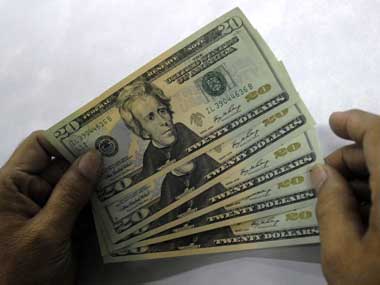By George Albert
The dollar bears have failed to push the greenback down for nearly three weeks, increasing the prospect of a further rally. This does not augur well for equities and the Indian rupee.
In an article published on 7 December 2011, we had mentioned that the dollar had reached a level of resistance and could sell off. Prices often fall from resistance levels. The dollar did sell off twice, which pushed up equities and the Indian rupee a bit.
However, a look at the chart now will show that the dollar index hit the resistance level between 80.80 and 81.50 twice. On Friday, the index hit the level a third time and went deeper into the resistance level. This shows that the bears have failed to sustain a selloff, indicating the strength of bulls.
If the index closes above 81.50 on any trading day, the dollar can rally higher. The number of times that the index hit the resistance level is shown on the chart with white arrows ( Click here for the dollar index chart ).
However, unless the resistance level is broken there is always the probability that the index could sell off. The probability of a selloff decreases the more the number of times prices come and hit the resistance level.
[caption id=“attachment_174937” align=“alignleft” width=“380” caption=“Aggressive traders can short the dollar right now and go long on equities. AFP”]  [/caption]
The logic is simple. Prices turn lower from resistance levels as the number of buyers exceeds sellers. As prices keep coming back to the level multiple times, the buyers are taking out sellers and eventually prices move higher.
On Friday, the dollar index moved back into the resistance level for the third time. This reduces the probability of a dollar selloff. If the index breaks the 81.50 level, it can go all the way up to the next resistance level of 83. A dollar rally usually does not augur well for the Indian rupee and equities. We could see the rupee fall, unless the Reserve Bank of India intervenes in the market.
Fundamentally, too, things are looking up for the dollar. The unemployment rate in the US has been falling for some time now and came in at 8.5 percent on Friday, slightly lower than the 8.6 percent last month. But the more positive aspect is that the US is adding private sector jobs at a decent rate. This is positive for the dollar.
On the other hand, Europe is seeing a contraction in the economy. Also, the European Central Bank (ECB) is pumping liquidity into the system by buying sovereign bonds (Italy is the latest example). These are negative factors for the euro and, by implication, positive for the dollar.
India and China are slowing down too. Given the tailwinds for the dollar, we could see it rallying some more.
Trading strategy: Unless the market has proven that the dollar will rally by breaking out of the 81.50 level, we’d do nothing. After the breakout we’d buy the dollar or short equities and the rupee, once the greenback rally corrects back to the 81.50 level. Some traders jump in at the breakout. We wait for a retracement as it is a more conservative play.
Aggressive traders can short the dollar right now and go long on equities, as there is still a chance that the dollar can sell off and equities rally. But if the Dollar index closes above 81.50 we’d close out our positions.
George Albert is Editor www.capturetrends.com


)
)
)
)
)
)
)
)
)



